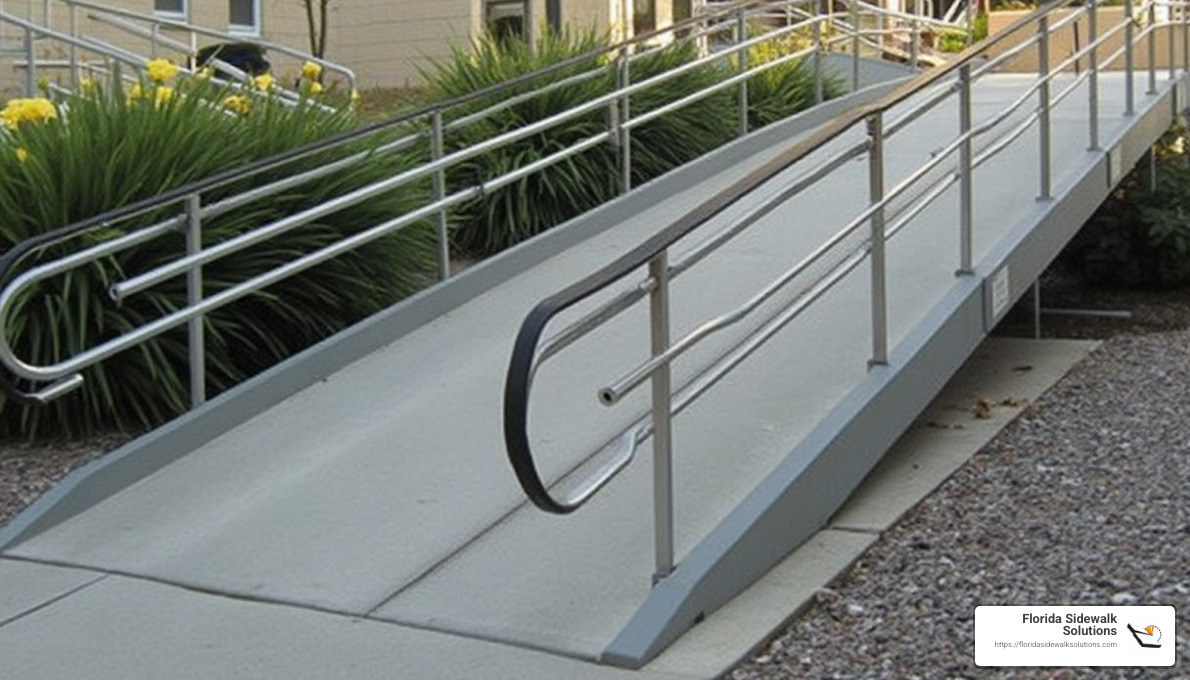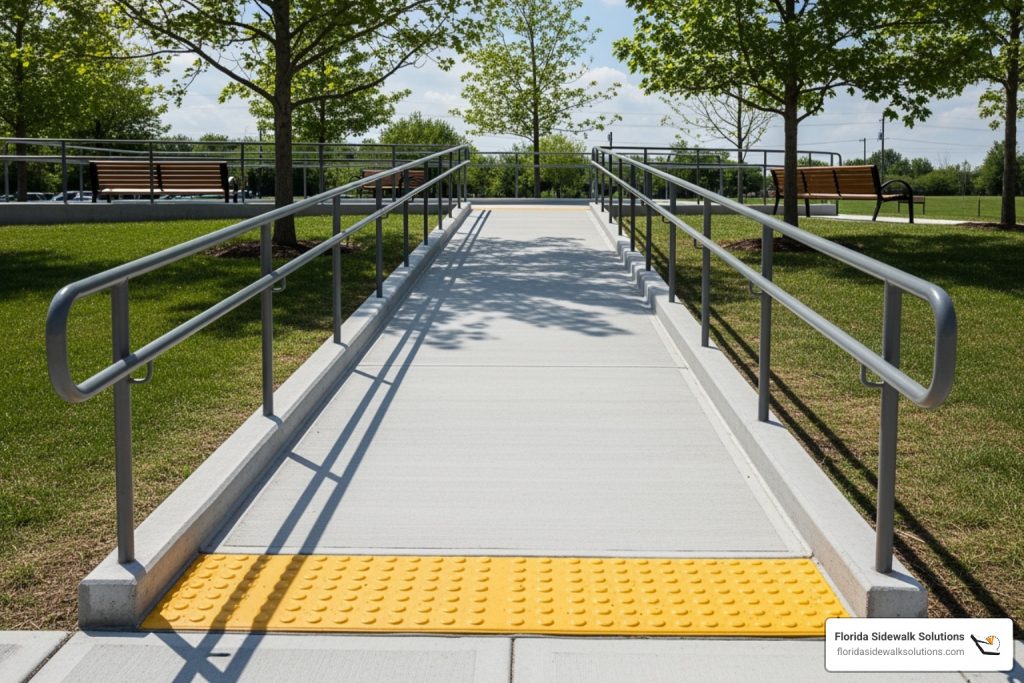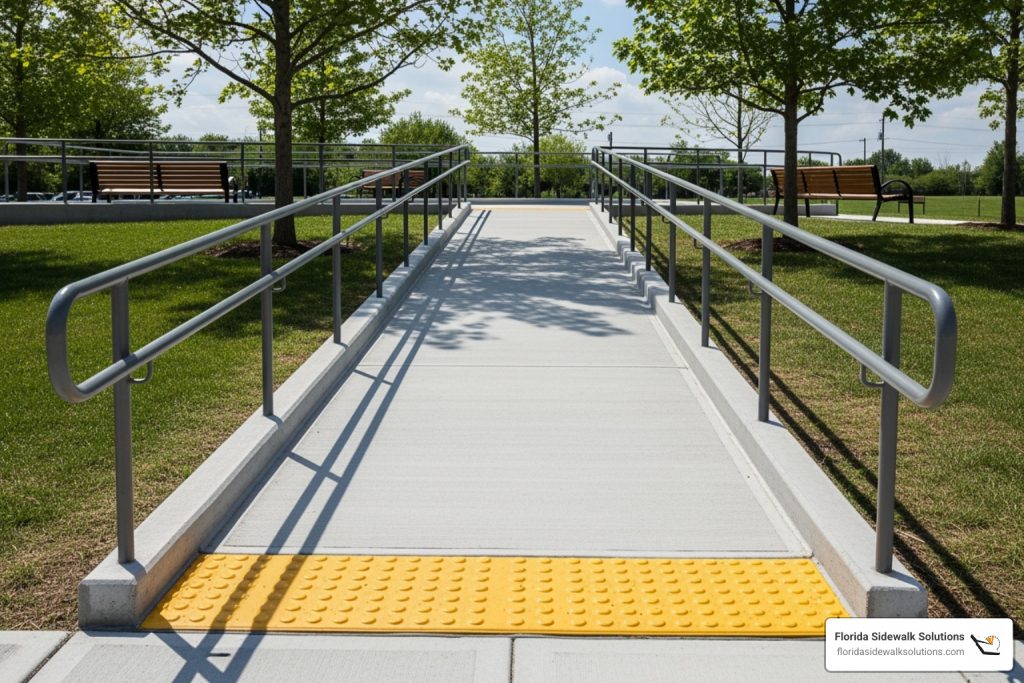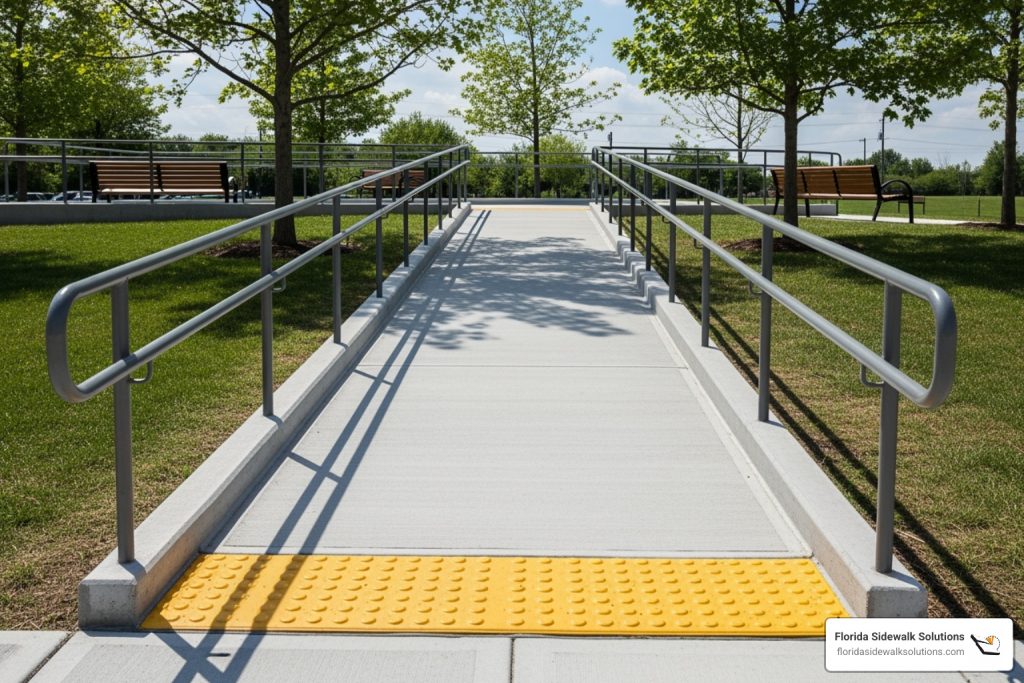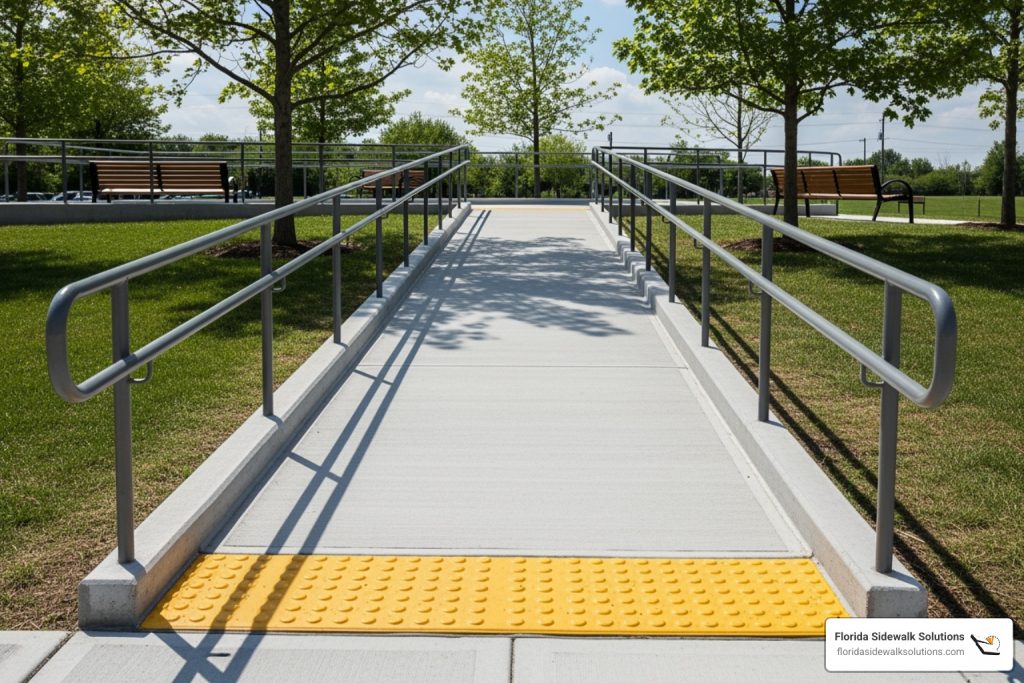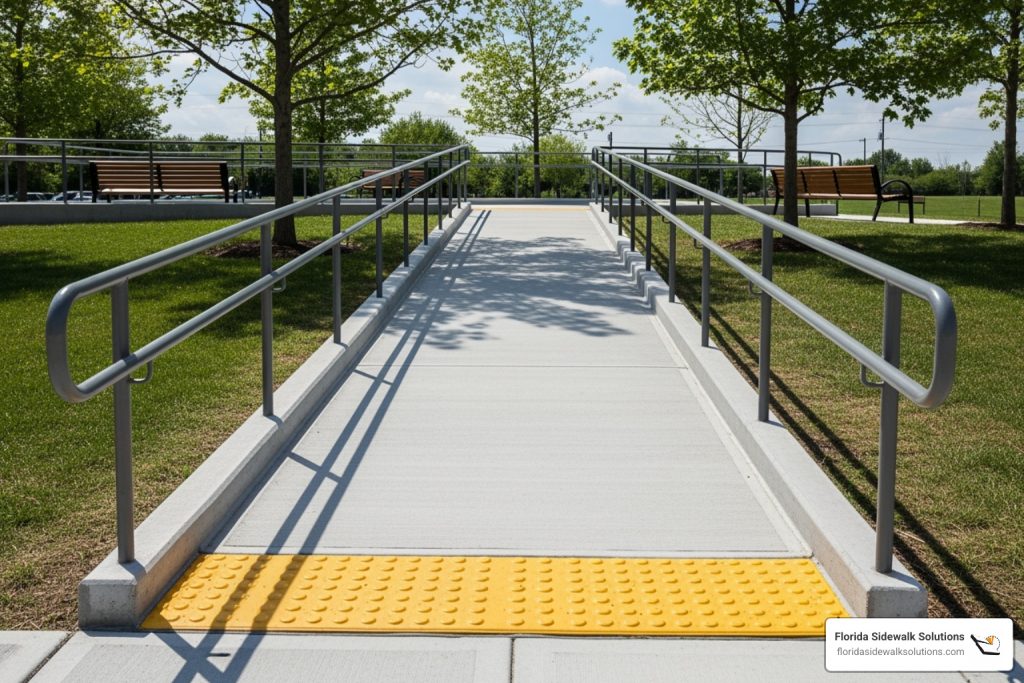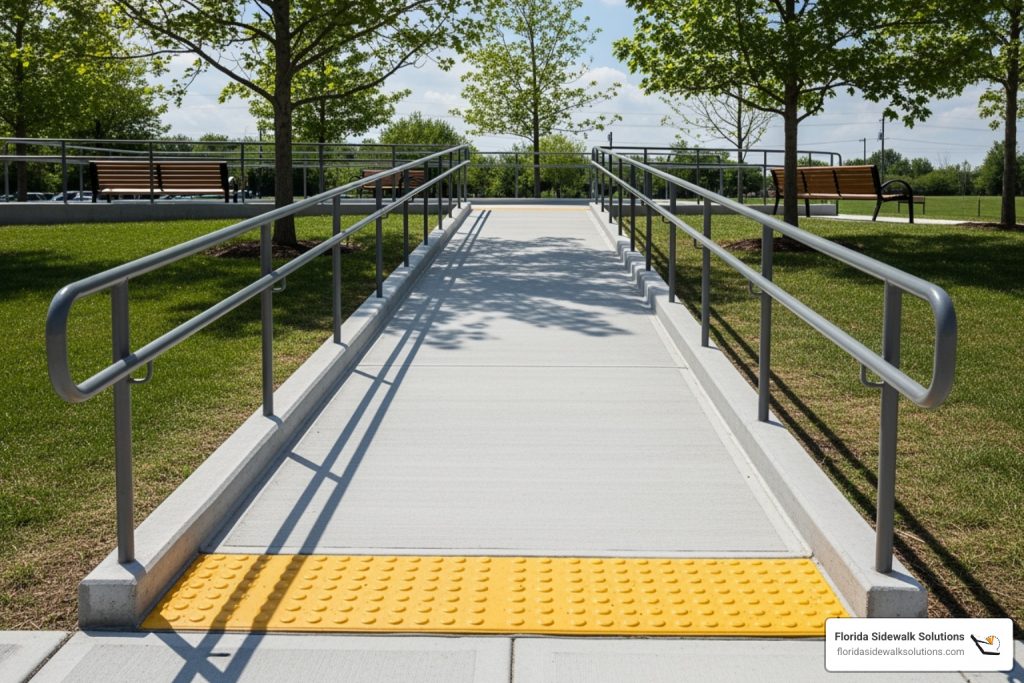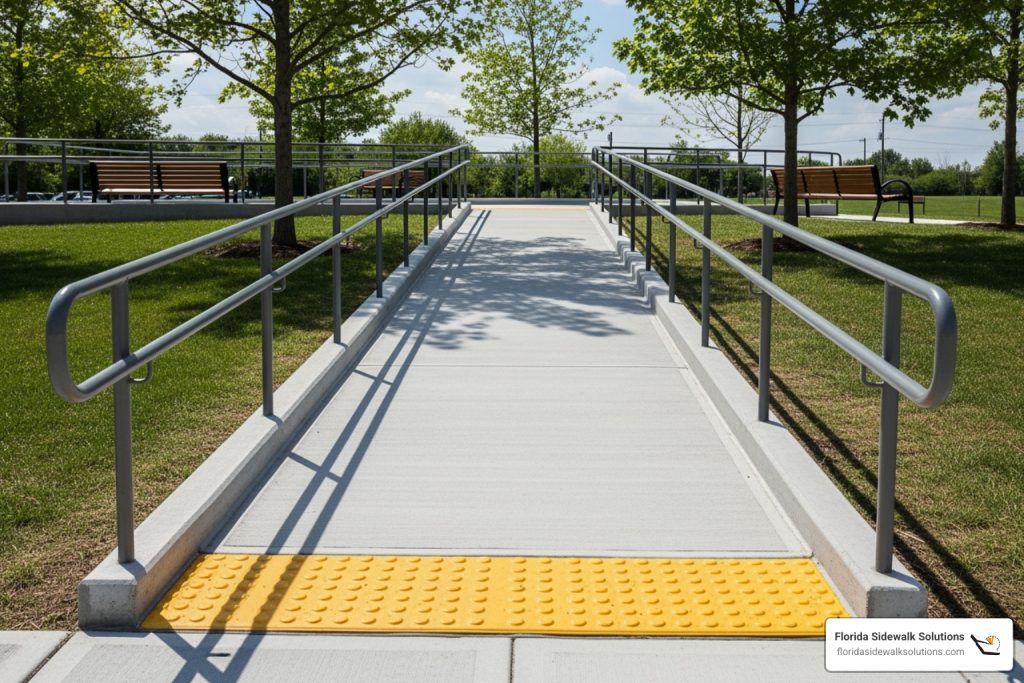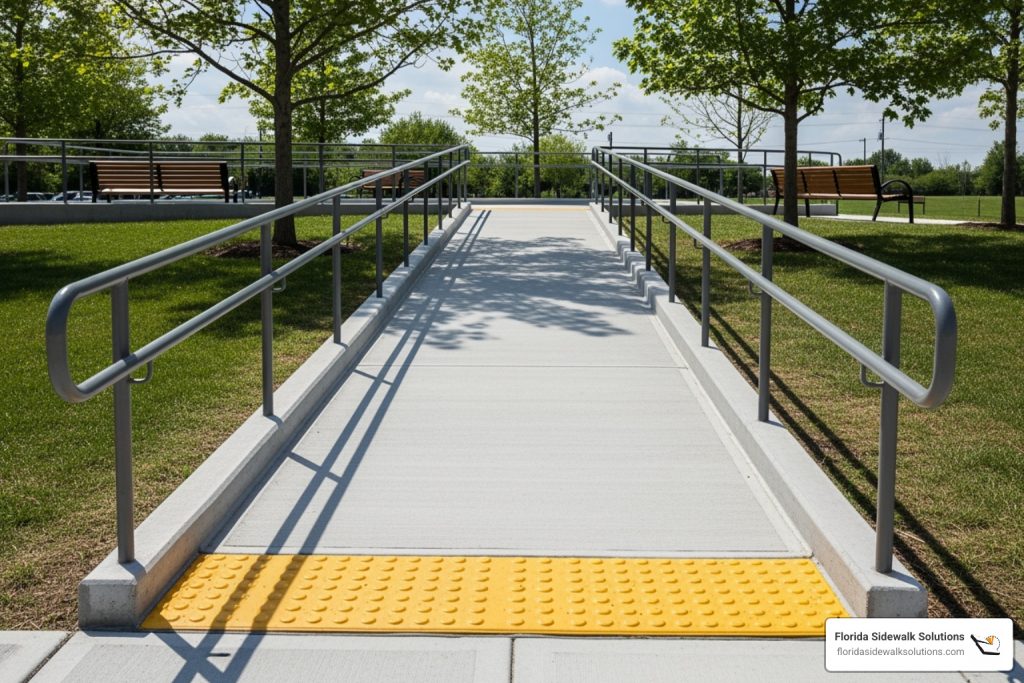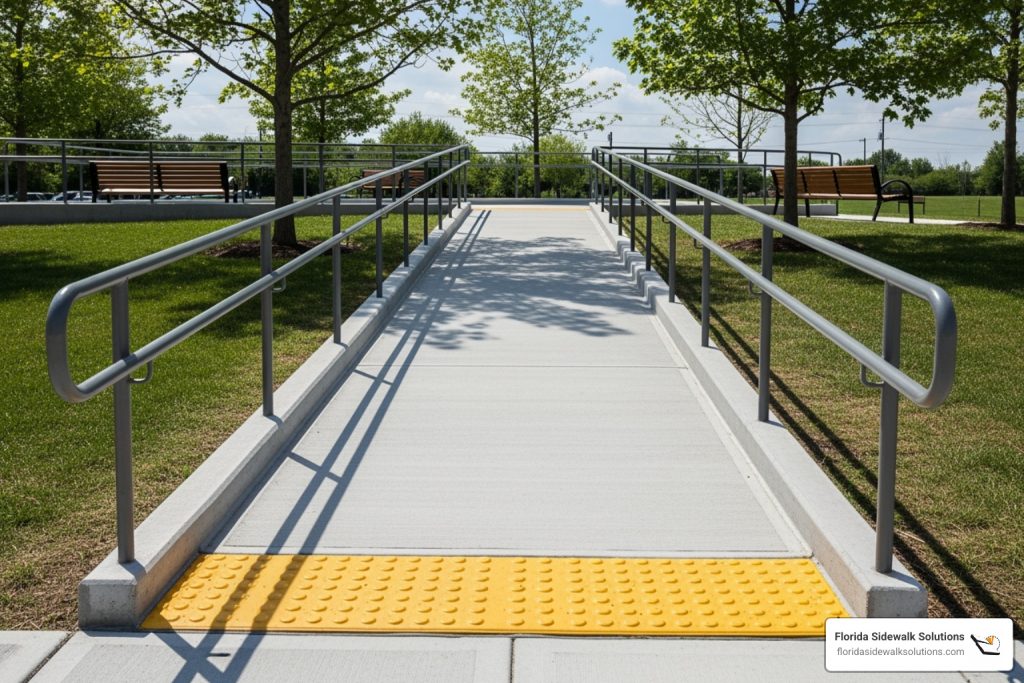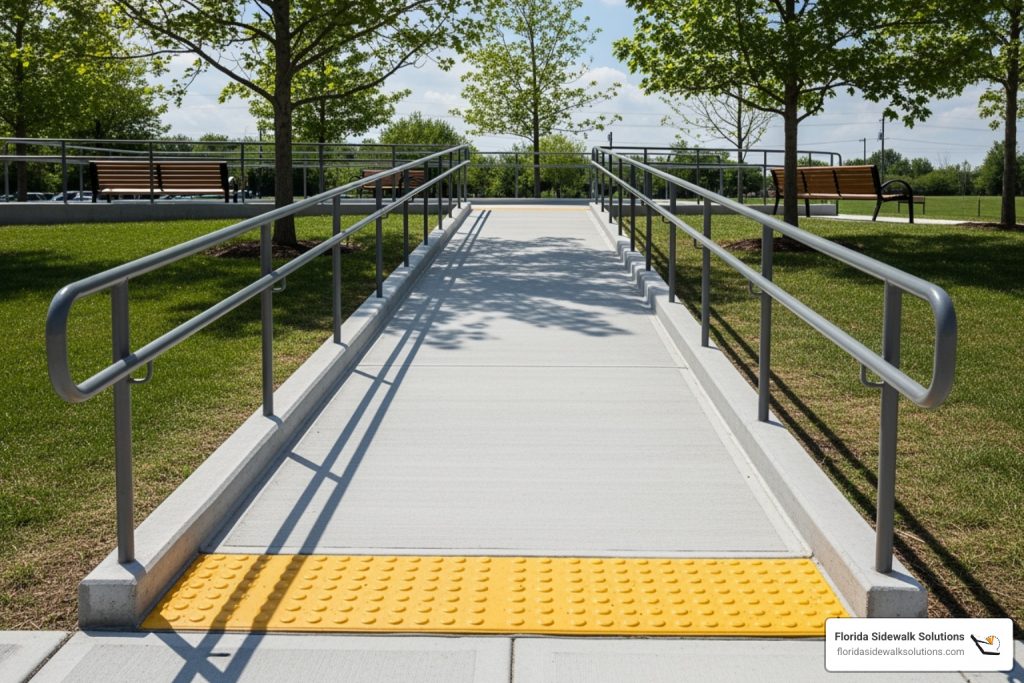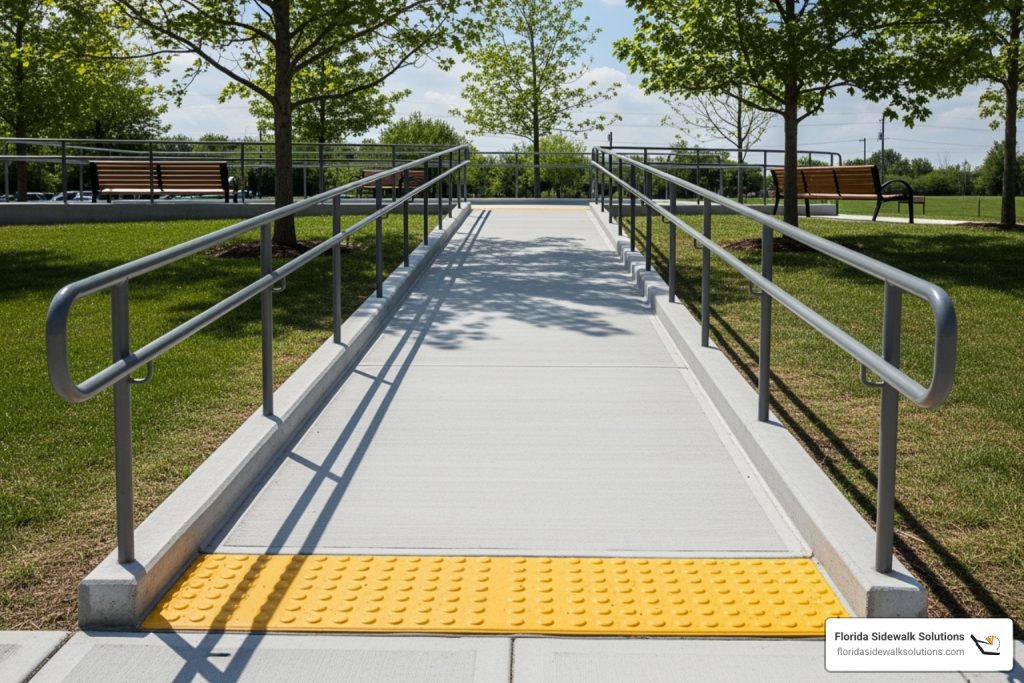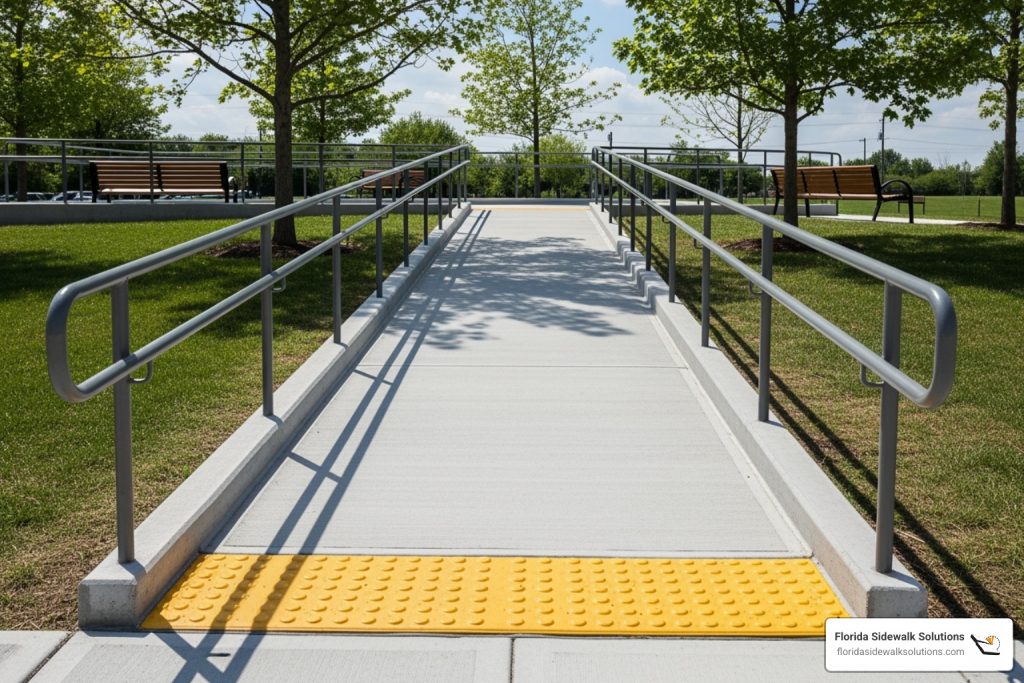ADA ramps are a crucial element in ensuring accessibility for everyone, especially those with disabilities. They help people steer public and private spaces safely and independently. When you hear ADA ramps, think about accessibility with a focus on the Americans with Disabilities Act (ADA). The aim is simple: make areas accessible to all individuals, avoiding discrimination.
-
Accessibility: Ramps allow individuals with wheelchairs, walkers, or mobility impairments to enter spaces they otherwise couldn’t.
-
ADA Compliance: To be compliant, ramps must meet specific standards, like having a 1:12 slope ratio and being at least 36 inches wide.
-
Public Safety: Proper ramps prevent accidents and make spaces more inclusive, helping cities meet legal duties to their residents.
Effective compliance with ADA standards makes environments friendly and accessible, benefiting everyone. Florida Sidewalk Solutions aims to address trip hazards while maintaining economic feasibility for municipal managers. By leveling sidewalks, they contribute significantly to ensuring ADA compliance more affordably.

Understanding ADA Ramp Requirements
When it comes to ADA ramps, there are several key requirements that ensure they are safe and accessible for everyone. Let’s break these down into simple terms.
Slope and Cross Slope
The slope of a ramp is crucial. It determines how steep the ramp is. The ADA requires a maximum running slope of 1:12. This means for every inch of height the ramp rises, it must be 12 inches long. This gentle slope ensures that people using wheelchairs can ascend and descend safely.
The cross slope, which is the slope perpendicular to the running slope, must not exceed a 1:48 ratio. This helps prevent wheelchairs from tipping over sideways.
Clear Width and Rise
Clear width refers to the width of the ramp, which must be at least 36 inches. This width allows enough space for wheelchairs and other mobility devices to pass through comfortably.
The rise, or the vertical height of a single ramp run, is limited to a maximum of 30 inches. If more height is needed, multiple runs with intermediate landings are required to break up the slope and provide resting areas.
Landings and Handrails
Landings are important resting points. They must be at least 60 inches long, providing enough space for users to pause and turn. This space is crucial for safety, especially if the ramp changes direction.
Handrails are mandatory on both sides of ramps with a rise greater than 6 inches. They must be between 34 and 38 inches above the ramp surface to assist users in maintaining balance. Handrail extensions of at least 12 inches beyond the top and bottom of the ramp provide extra support.
Edge protection is also necessary to prevent wheelchairs from slipping off the ramp. This can be achieved through extended ground surfaces or barriers that are no more than 4 inches from the bottom of the guardrail.
By adhering to these requirements, ADA ramps ensure accessibility and safety for everyone. They are not just about meeting regulations; they are about creating inclusive spaces that welcome all individuals. Florida Sidewalk Solutions is committed to making this a reality by providing effective and economical solutions for ADA compliance.
ADA Ramps in Public Spaces
Public spaces need to be accessible for everyone, including people with disabilities. ADA ramps play a crucial role in ensuring accessibility, especially at pedestrian crossings and transportation stops. Let’s explore how these ramps are designed to meet ADA standards.
Curb Ramps and Pedestrian Crossings
Curb ramps are essential for providing smooth transitions between sidewalks and streets. These ramps are particularly important at pedestrian crossings, where people need to safely cross the road. A common design is the perpendicular curb ramp, which leads directly into the crosswalk and provides a straight path for wheelchair users.
Side flares are sloped surfaces on either side of a curb ramp. They help prevent tripping and allow easier access. However, these flares must be gentle enough to be navigable by wheelchairs.
The top landing of a curb ramp should be level and spacious enough for a wheelchair to stop and change direction if necessary. This is crucial for safety and ease of use.
Detectable Warnings
Detectable warnings are a vital feature of ADA ramps. These are tactile surfaces with dome-shaped bumps that alert individuals who are blind or have low vision. They indicate the transition from a pedestrian area to a street or other hazardous area.
Detectable warnings must cover the entire width of the curb ramp and extend at least two feet back from the street edge. This design ensures that individuals can feel the warning with their feet before entering traffic.
These tactile warnings are especially important at public transportation stops. They help guide individuals safely to buses and trains, ensuring that everyone can steer public spaces independently.

By incorporating these features, public spaces become more inclusive and accessible. Florida Sidewalk Solutions is dedicated to providing innovative solutions that meet these standards, ensuring that everyone can move safely and independently in public areas.
ADA Ramps for Businesses
Businesses play a vital role in ensuring accessibility for all. One way to achieve this is by installing ADA ramps, which provide safe and easy access for individuals with disabilities. Let’s explore how businesses can improve accessibility with ADA-compliant solutions, focusing on the services offered by Florida Sidewalk Solutions.
Florida Sidewalk Solutions ADA Ramps
When it comes to creating accessible business environments, Florida Sidewalk Solutions offers effective methods to ensure compliance with ADA standards. Their expertise in sidewalk trip hazard repair and ADA compliance makes them a reliable choice for businesses.
Concrete Cutting Method: Florida Sidewalk Solutions specializes in cutting concrete sidewalks to make them level, which is more effective and less expensive than conventional methods like scabblers, concrete grinders, or removal and replacement. This approach ensures durability and safety, making it ideal for outdoor use.
ADA Compliance: Safety is a top priority. Florida Sidewalk Solutions ensures that their methods comply with ADA standards, providing a secure environment for employees and customers alike.
Custom Solutions: One of the standout features of Florida Sidewalk Solutions is their ability to provide custom solutions. They can address various layout needs, making them suitable for businesses with unique entrance requirements. Whether your entrance requires leveling or specific adjustments, their methods can be tailored accordingly.
Enhanced Aesthetics: Safety and aesthetics go hand in hand. Florida Sidewalk Solutions’ methods not only provide support but also enhance the overall appearance of your business entrance, ensuring a polished look.
By incorporating these features, businesses can ensure that their premises are accessible to all individuals, regardless of their mobility needs. Florida Sidewalk Solutions offers a reliable and stylish solution for any business looking to improve its accessibility.
Next, we’ll address some common questions about ADA ramp requirements and provide guidance on navigating these essential features.

By focusing on these solutions, businesses can enhance accessibility and ensure compliance with legal standards, ultimately leading to increased customer satisfaction. For more information, visit Florida Sidewalk Solutions.
Frequently Asked Questions about ADA Ramps
When it comes to ADA ramps, there are a few questions that often come up. Let’s address these to help you understand the essentials.
What are the ADA requirements for a ramp?
ADA ramps must follow specific guidelines to ensure they’re accessible and safe for everyone.
-
Clear Width: The ramp must be at least 36 inches wide, providing enough space for easy wheelchair navigation.
-
Rise: Each run of the ramp can rise up to a maximum of 30 inches. If more height is needed, multiple runs with landings in between are required.
-
Slope: The maximum running slope is 1:12, meaning for every inch of vertical rise, there should be at least 12 inches of ramp length. This ensures a gentle incline that’s manageable for wheelchair users.
Does Medicare pay for handicap ramps?
Medicare typically does not cover the cost of installing handicap ramps. However, there are other options available for financing home modifications:
-
Home Improvement Loans: Many financial institutions offer loans specifically for home accessibility modifications.
-
State and Local Agencies: Some local programs provide grants or loans with favorable terms to assist with these modifications.
-
Veterans Affairs: If you’re a veteran, you might qualify for grants from the U.S. Department of Veterans Affairs to help cover the cost of home modifications.
Are curved or circular ramps allowed?
Curved or circular ramps can be used, but they must meet specific requirements to ensure safety.
-
Compound Slopes: Curved ramps must avoid compound slopes, which can create uneven surfaces and make navigation difficult for wheelchair users.
-
Level Landings: At every change in direction or every 30 inches of rise, a level landing is required. This provides a resting spot and ensures the ramp remains safe and accessible.
By understanding these key points, you can ensure that any ADA ramp you install meets the necessary standards and provides safe, accessible passage for everyone.
Conclusion
At Florida Sidewalk Solutions, we understand the importance of ensuring sidewalks and walkways are safe and accessible for everyone. Our mission is to remove trip hazards and achieve ADA compliance through innovative and cost-effective methods.
Our unique approach involves cutting concrete sidewalks to make them level, which is more effective and less expensive than traditional methods like scabblers or grinders. This not only saves money but also ensures that the paths are smooth and compliant with ADA standards.
The Americans with Disabilities Act sets clear guidelines to make public spaces accessible to all, including those with disabilities. For sidewalks and curb ramps, this means adhering to specific requirements for slope, width, and surface texture. By addressing these elements, we help create an environment where everyone can move safely and independently.
In cities like Philadelphia, where a settlement agreement mandates the installation or remediation of thousands of curb ramps, the impact of compliance is evident. It’s a testament to the power of community action and legal advocacy in making cities more inclusive.
We are proud to contribute to this mission in Florida, with locations across the state, including Davie, Fort Lauderdale, and Miami. Our team is dedicated to improving accessibility and ensuring that sidewalks are free from hazards that could impede safe travel.
If you’re interested in learning more about our services or need help making your sidewalks ADA-compliant, contact us today. Let’s work together to create safer, more accessible communities for everyone.

